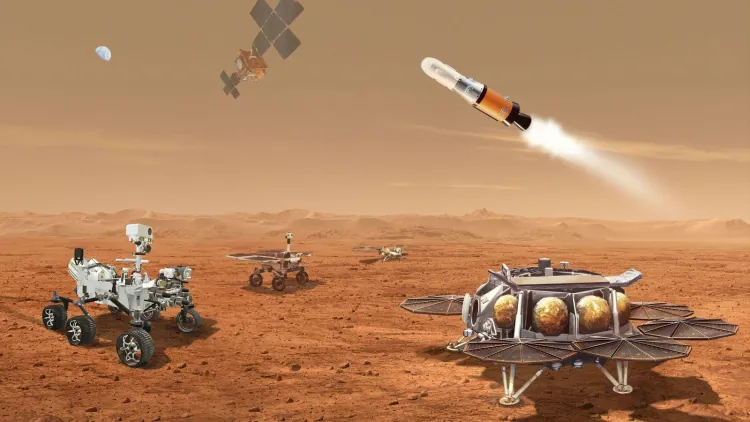Mars Sample Return Mission
Challenges Ahead for NASA's Mars Sample Return Mission: An In-depth Analysis

: Explore the multifaceted challenges NASA's Mars Sample Return Mission faces, from escalating costs to technical complexities, as it aims to bring back Mars samples to Earth for the first time.
Outline
- Introduction
- The Ambition of Mars Sample Return Mission
- Overview of the Mission
- Partnership with ESA
- Technical and Operational Complexities
- Mission Design
- Coordination Challenges
- Financial Overruns and Schedule Delays
- Increasing Cost Estimates
- Impact on Launch Dates
- Strategic Revisions and Recommendations
- NASA’s Response to Audit Recommendations
- Future Strategy for MSR
- Implications for NASA and ESA
- Resource Allocation
- Impact on Future Missions
- Public and Scientific Expectations
- Scientific Value of Mars Samples
- Public Interest in Space Exploration
- Challenges of Interagency Collaboration
- NASA and ESA Coordination Efforts
- Revising Mission Objectives
- Adjustments and Design Simplifications
- Conclusion
- FAQs
Introduction
The Mars Sample Return (MSR) Mission, a monumental endeavor spearheaded by NASA in collaboration with the European Space Agency (ESA), is at a critical juncture. As it navigates through the complexities of interplanetary exploration, the mission is confronted with significant challenges that could redefine the future of space science and exploration. This article delves into the intricacies of the mission, highlighting the hurdles it faces and the implications for the broader scientific community.
The Ambition of Mars Sample Return Mission
Overview of the Mission
The MSR Mission, one of the most ambitious projects ever undertaken in the realm of robotic space exploration, aims to collect samples from the Martian surface and return them to Earth. This initiative promises to unlock secrets of the Red Planet's past, potentially revealing evidence of ancient life.
Partnership with ESA
In a testament to international cooperation, NASA has joined forces with ESA to accomplish this groundbreaking mission. The collaboration underscores the global significance of Mars exploration, pooling resources and expertise to achieve common scientific goals.
Technical and Operational Complexities
Mission Design
The mission's design is a marvel of engineering, involving multiple robots and spacecraft to transport the Martian samples back to Earth. However, this complexity introduces a plethora of challenges, from technical hurdles to logistical obstacles.
Coordination Challenges
Effective coordination between NASA and ESA is crucial for the mission's success. Past experiences have underscored the importance of transparent communication and synchronized efforts in overcoming the challenges inherent in such a complex mission.
Financial Overruns and Schedule Delays
Increasing Cost Estimates
Recent audits have revealed concerning escalations in the mission's cost estimates, with projections now significantly exceeding initial forecasts. This financial strain poses a critical challenge to the mission's viability and timeline.
Impact on Launch Dates
As costs balloon, the mission's launch dates are pushed further into the future, jeopardizing the planned timeline and adding uncertainty to an already complex endeavor.
Strategic Revisions and Recommendations
NASA’s Response to Audit Recommendations
In response to the audit's findings, NASA has initiated strategic revisions to address the identified issues. These changes are aimed at realigning the mission with realistic cost and schedule estimates.
Future Strategy for MSR
The revised strategy for the MSR Mission will be a pivotal moment in the project's development, determining its feasibility and setting the stage for its execution.
Implications for NASA and ESA
Resource Allocation
The challenges facing the MSR Mission have significant implications for both NASA and ESA, affecting resource allocation and potentially impacting other scientific missions.
Impact on Future Missions
The outcome of the MSR Mission and the lessons learned from its challenges will undoubtedly influence future interplanetary exploration efforts, shaping the trajectory of space science for years to come.
Public and Scientific Expectations
Scientific Value of Mars Samples
The potential scientific rewards of successfully returning Mars samples to Earth are immense, offering unparalleled insights into the planet's geological and potentially biological history.
Public Interest in Space Exploration
The MSR Mission captivates the public imagination, symbolizing human ingenuity and the relentless pursuit of knowledge beyond our planet.
Challenges of Interagency Collaboration
NASA and ESA Coordination Efforts
The mission's success hinges on the seamless collaboration between NASA and ESA, a complex dance of interagency coordination that must navigate the intricacies of international space exploration.
Revising Mission Objectives
Adjustments and Design Simplifications
In light of the challenges encountered, the mission's objectives and design are subject to revisions, aiming to streamline the process and ensure the mission's success within the constraints of budget and timeline.
Summary:
NASA's ambitious Mars Sample Return (MSR) mission is encountering significant hurdles in its path to bring back samples from Mars, as pointed out by a recent Inspector General report. Facing complexities in mission design, unexpected cost increases, and the need for a revised strategy in partnership with the European Space Agency (ESA), the mission's journey is proving to be as challenging as it is groundbreaking. With technological innovation at its core, the mission seeks to return Mars samples to Earth for in-depth analysis, potentially unlocking secrets of the red planet's past. However, achieving this goal requires overcoming a series of technical, financial, and collaborative obstacles, underscoring the mission's high stakes and high reward nature.
Conclusion
The Mars Sample Return Mission stands as a testament to human ambition and the quest for knowledge. Despite the hurdles it faces, the mission embodies the spirit of exploration and the boundless potential of collaboration in unraveling the mysteries of our universe.
FAQs
- What is the Mars Sample Return Mission?
- Why is the MSR Mission important for scientific research?
- What challenges has the MSR Mission faced?
- How are NASA and ESA collaborating on the MSR Mission?
- What are the implications of the mission's cost overruns?
- How will the MSR Mission impact future space exploration efforts?
What's Your Reaction?






















